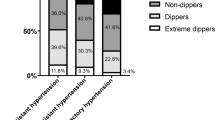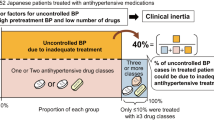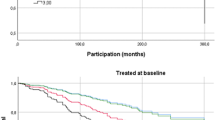Abstract
Blood pressure (BP) response to diuretics is varied in hypertensive patients. This study aimed to identify the patients who may respond better or worse to thiazide diuretics. Nondiabetic patients with treated or untreated hypertension were evaluated if they did not take diuretics and their office systolic BP (SBP) >140 mm Hg or diastolic BP (DBP) >90 mm Hg. Diet and life style modification were advised in addition to the concomitant medication, if there were, for 2 weeks. Additional hydrochlorothiazide 50 mg was given per day for another 2 weeks. Both office and 24-h ambulatory BP were checked. The changes of office SBP were used for the response to thiazide treatment. A total of 92 patients were enrolled. Compared with those in the quartile of worst response, patients in the quartile of best response were older with increased baseline SBP and pulse pressure (PP) and reduced heart rate. Reduced baseline awake, but not increased sleep DBP was associated with better response to thiazide. Besides, baseline age, SBP and PP were correlated to the response to thiazide treatment. Among these variables, increased baseline mean BP independently predicted the best and reduced SBP predicted the worst responders. Accordingly, patients with higher mean BP respond better to thiazide treatment no matter with or without concomitant medication. Patients with mainly diastolic hypertension with lower SBP responded poorly to thiazide treatment. The findings may help to individualized use of thiazide in nondiabetic hypertensives.
This is a preview of subscription content, access via your institution
Access options
Subscribe to this journal
Receive 12 digital issues and online access to articles
$119.00 per year
only $9.92 per issue
Buy this article
- Purchase on Springer Link
- Instant access to full article PDF
Prices may be subject to local taxes which are calculated during checkout



Similar content being viewed by others
References
Gu D, Reynolds K, Wu X, Chen J, Duan X, Muntner P, et al., InterASIA Collaborative Group. The International Collaborative Study of Cardiovascular Disease in ASIA. Prevalence, awareness, treatment, and control of hypertension in china. Hypertension 2002; 40: 920–927.
Lloyd-Jones DM, Evans JC, Larson MG, Levy D . Treatment and control of hypertension in the community: a prospective analysis. Hypertension 2002; 40: 640–646.
Mancia G, Grassi G . Systolic and diastolic blood pressure control in antihypertensive drug trials. J Hypertens 2002; 20: 1461–1464.
The ALLHAT Officers and Coordinators for the ALLHAT Collaborative Research Group. Major outcomes in high-risk hypertensive patients randomized to angiotensin-converting enzyme inhibitor or calcium channel blocker vs diuretic: the Antihypertensive and Lipid-Lowering Treatment to Prevent Heart Attack Trial (ALLHAT). JAMA 2002; 288: 2981–2997.
Wright Jr JT, Dunn JK, Cutler JA, Davis BR, Cushman WC, Ford CE, et al., ALLHAT Collaborative Research Group. Outcomes in hypertensive black and nonblack patients treated with chlorthalidone, amlodipine, and lisinopril. JAMA 2005; 293: 1595–1608.
Psaty BM, Lumley T, Furberg CD, Schellenbaum G, Pahor M, Alderman MH et al. Health outcomes associated with various antihypertensive therapies used as first-line agents: a network meta-analysis. JAMA 2003; 289: 2534–2544.
Hypertension Detection and Follow-up Program Cooperative Group. Five-year findings of the hypertension detection and follow-up program: I. Reduction in mortality of persons with high blood pressure, including mild hypertension. JAMA 1979; 242: 2562–2571.
The Multiple Risk Factor Intervention Trial Research Group (MRFIT). Mortality after 10.5 years for hypertensive participants in the Multiple Risk Factor Intervention Trial. Circulation 1990; 82: 1616–1628.
SHEP Cooperative Research Group. Prevention of stroke by antihypertensive drug treatment in older persons with isolated systolic hypertension. Final results of the Systolic Hypertension in the Elderly Program (SHEP). JAMA 1991; 265: 3255–3264.
Neaton JD, Grimm Jr RH, Prineas RJ, Stamler J, Grandits GA, Elmer PJ et al. Treatment of mild hypertension study. Final results. Treatment of Mild Hypertension Study Research Group. JAMA 1993; 270: 713–724.
Van Zwieten PA . Comparative mechanisms of action of diuretic drugs in hypertension. Eur Heart J 1992; 13 (Suppl G): 2–4.
Whitworth JA, World Health Organization, International Society of Hypertension Writing Group. 2003 World Health Organization (WHO)/International Society of Hypertension (ISH) statement on management of hypertension. J Hypertens 2003; 21: 1983–1992.
Chobanian AV, Bakris GL, Black HR, Cushman WC, Green LA, Izzo Jr JL et al. The seventh report of the Joint National Committee on prevention, detection, evaluation, and treatment of high blood pressure: the JNC 7 report. JAMA 2003; 289: 2560–2572.
Lindholm LH, Persson M, Alaupovic P, Carlberg B, Svensson A, Samuelsson O . Metabolic outcome during 1 year in newly detected hypertensives: results of the Antihypertensive Treatment and Lipid Profile in a North of Sweden Efficacy Evaluation (ALPINE study). J Hypertens 2003; 21: 1563–1574.
Maitland-van der Zee AH, Turner ST, Schwartz GL, Chapman AB, Klungel OH, Boerwinkle E . Demographic, environmental, and genetic predictors of metabolic side effects of hydrochlorothiazide treatment in hypertensive subjects. Am J Hypertens 2005; 18: 1077–1083.
Tarazi RC . Pathophysiology of essential hypertension. Role of the autonomic nervous system. Am J Med 1983; 75: 2–8.
Beretta-Piccoli C, Weidmann P, Brown JJ, Davies DL, Lever AF, Robertson JI . Body sodium blood volume state in essential hypertension: abnormal relation of exchangeable sodium to age and blood pressure in male patients. J Cardiovasc Pharmacol 1984; 6 (Suppl 1): S134–S142.
Uzu T, Kimura G . Diuretics shift circadian rhythm of blood pressure from nondipper to dipper in essential hypertension. Circulation 1999; 100: 1635–1638.
Yamamoto Y, Akiguchi I, Oiwa K, Hayashi M, Kimura J . Adverse effect of nighttime blood pressure on the outcome of lacunar infarct patients. Stroke 1998; 29: 570–576.
Pierdomenico SD, Bucci A, Costantini F, Lapenna D, Cuccurullo F, Mezzetti A . Circadian blood pressure changes and myocardial ischemia in hypertensive patients with coronary artery disease. J Am Coll Cardiol 1998; 31: 1627–1634.
Hyman DJ, Pavlik VN . Characteristics of patients with uncontrolled hypertension in the United States. N Engl J Med 2001; 345: 479–486.
Neaton JD, Blackburn H, Jacobs D, Kuller L, Lee DJ, Sherwin R . Serum cholesterol level and mortality findings for men screened in the Multiple Risk Factor Intervention Trial. Multiple Risk Factor Intervention Trial Research Group. Arch Intern Med 1992; 152: 1490–1500.
Hansson L, Zanchetti A, Carruthers SG, Dahlof B, Elmfeldt D, Julius S et al. Effects of intensive blood-pressure lowering and low-dose aspirin in patients with hypertension: principal results of the hypertension optimal treatment (HOT) randomized trial. HOT Study Group. Lancet 1998; 351: 1755–1762.
Black HR, Kuller LH, O'Rourke MF, Weber MA, Alderman MH, Benetos A . The first report of the systolic and pulse pressure (SYPP) Working Group. J Hypertens Suppl 1999; 17: S3–14.
Lewington S, Clarke R, Qizilbash N, Peto R, Collins R . Prospective Studies Collaboration. Age-specific relevance of usual blood pressure to vascular mortality: a meta-analysis of individual data for one million adults in 61 prospective studies. Lancet 2002; 360: 1903–1913.
Izzo Jr JL, Levy D, Black HR . Clinical advisory statement. Importance of systolic blood pressure in older Americans. Hypertension 2000; 35: 1021–1024.
Lakatta EG, Levy D . Arterial and cardiac aging: major shareholders in cardiovascular disease enterprises: part I: aging arteries: a “set up” for vascular disease. Circulation 2003; 107: 139–146.
Breithaupt-Grogler K, Leschinger M, Belz GG, Butzer R, Erb K, de May C et al. Influence of antihypertensive therapy with cilazapril and hydrochlorothiazide on the stiffness of the aorta. Cardiovasc Drugs Ther 1996; 10: 49–57.
Spoelstra-de Man AM, van Ittersum FJ, Schram MT, Kamp O, van Dijk RA, Ijzerman RG et al. Aggressive antihypertensive strategies based on hydrochlorothiazide, candesartan or lisinopril decrease left ventricular mass and improve arterial compliance in patients with type II diabetes mellitus and hypertension. J Hum Hypertens 2006; 20: 599–611.
Weitzman D, Goldbourt U . The significance of various blood pressure indices for long-term stroke, coronary heart disease, and all-cause mortality in men: the Israeli Ischemic Heart Disease study. Stroke 2006; 37: 358–363.
Sesso HD, Stampfer MJ, Rosner B, Hennekens CH, Gaziano JM, Manson JE et al. Systolic and diastolic blood pressure, pulse pressure, and mean arterial pressure as predictors of cardiovascular disease risk in men. Hypertension 2000; 36: 801–807.
Miura K, Soyama Y, Morikawa Y, Nishijo M, Nakanishi Y, Naruse Y et al. Comparison of four blood pressure indexes for the prediction of 10-year stroke risk in middle-aged and older Asians. Hypertension 2004; 44: 715–720.
Pickkers P, Hughes AD, Russel FG, Thien T, Smits P . Thiazide-induced vasodilation in humans is mediated by potassium channel activation. Hypertension 1998; 32: 1071–1076.
Author information
Authors and Affiliations
Corresponding author
Rights and permissions
About this article
Cite this article
Huang, CC., Leu, HB., Wu, TC. et al. Clinical predictors of the response to short-term thiazide treatment in nondiabetic essential hypertensives. J Hum Hypertens 22, 329–337 (2008). https://doi.org/10.1038/sj.jhh.1002330
Received:
Revised:
Accepted:
Published:
Issue Date:
DOI: https://doi.org/10.1038/sj.jhh.1002330



